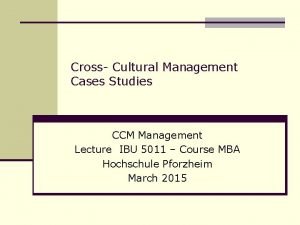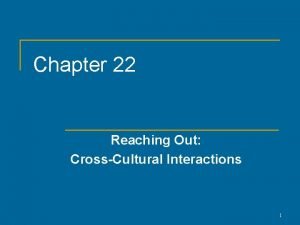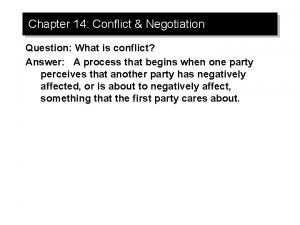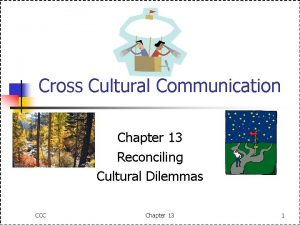Cross Cultural Management and Negotiation Practices Chapter 14

















- Slides: 17

Cross Cultural Management and Negotiation Practices Chapter 14 – Communication: Listening to Understand Dr. Bahaudin G. Mujtaba © Bahaudin G. Mujtaba

Chapter Topics • Chapter 14 – Communication: Listening to Understand – Effective Communication • • • Listening and Management Communication Listening Basics Autobiographical responses Listening without judgment Listening empathically Benefits of listening – Overcoming Barriers to Communication © Bahaudin G. Mujtaba

Communication • Communication takes place whether it is intended or not. Human beings have communicated for thousands of years and some major miscommunication experiences have been documented in books and cultural stories. Such experiences can teach human beings historical trends and their outcomes. • Communication is the process of exchanging information in ways that ensure a mutual understanding of content and feelings; this includes being heard and understood. • Effective communication can also be defined as the transfer of information from one person to other(s), without the meaning being changed. Often communication takes the forms of speaking and listening. • While speaking is done for the purpose of being understood, listening is the real tool for understanding, learning and growing. Being a good listener sets you apart and helps you become a much better communicator while speaking. © Bahaudin G. Mujtaba

The Basics of Communication • WHO will communicate: the appropriate addressor • TO WHOM: the appropriate person or persons to whom the message should be communicated – the addressee/s or audience • WHAT: appropriate content of the message • HOW: appropriate language, medium, and style, for communicating the message • WHEN: appropriate time for communicating the message • WHERE: appropriate location for communicating the message. • WHY: appropriate reasons for communicating the message through the chosen medium. © Bahaudin G. Mujtaba

Cultural Variables in Communication Attitudes Encodes the message Thought patterns Stereotypes Decodes the message Roles Space Sender Time sense Receiver Social organizations Perceptual Filters Objective of effective communication is “mutual understanding. ”

Communication is a process of sharing information with another person in such a way that s/he understands what you are saying. Intercultural communication is the process of sharing information or interacting with a person from another culture.

Intercultural Communication Skills • • Withhold judgment Show respect Empathize Tolerate ambiguity Recognize your own cultural biases Emphasize common ground Send clear messages Learn when to be direct © Bahaudin G. Mujtaba

Autobiographical Responses • A dvise • P robe • I nterpret • E valuate

Autobiographical Responses • Advise: Telling others what they should do based on our (biased) perspective. We advise when we make recommendations or suggestions based on our own past experiences. • Probe: Asking questions to direct the conversation toward things that come from our frame of reference. We probe when we question the speaker to find similarities with our past experiences. • Interpret: Explaining why they are acting the way they do based on our experiences. When we interpret we are explaining others’ behaviors and actions based on our own past actions. • Evaluate: Judging (agreeing or disagreeing with) the situation, which could be verbal, facial, or through body posture, based on one’s opinion. We are evaluating when we judge by either agreeing or disagreeing based on our own values. © Bahaudin G. Mujtaba

Levels of Listening • • • Ignoring. Not paying any attention, sleeping, talking, etc. Not caring. You don’t receive messages at this level. You don’t concentrate on listening. Pretending. Giving the appearance of listening, occasional nod or a response. You give the appearance of listening. You give an occasional head nod or similar form of body language to make the sender think that you’re listening, but you’re really not. Selecting. Grasping certain key words here or there but not listening. You select parts of the message that you feel are important. You don’t hear or you instantly lose other parts of the message. Attending or active listening. Listening intently, grasping the content and perhaps even repeating back what you heard; listening with ears for the facts. You’re focusing on the message being communicated. You’re listening for content and asking questions for clarification. Empathic. The highest level of listening. Listening with the eyes and the heart for feelings and emotions. It is seeing how the sender sees the situation. You’re now seeking to understand the emotions and feelings of the sender, as well as understand the content of the message being communicated. This is the highest level of listening. © Bahaudin G. Mujtaba

Active Listening Active listening involves providing feedback to ensure understanding by – repeating the message verbatim, – stating the meaning of the message as you understand it, and – asking questions for clarification, if necessary.

Empathic Listening Empathic listening is the process of discovering the sender’s perspective, thoughts, and feelings by encouraging the sender to self-disclose through active listening and/or empathy. – Empathic listening involves listening with the eyes and heart for feelings and listening with the ears for facts, thoughts and views.

Empathic Listening Process Empathic listening process involves the following steps: – Repeating the message verbatim. – Summarizing the content of the message. – Reflecting on the feelings of the message. – Restating the content of the message in your own words and reflecting the feelings of the message. – Using good judgment and determining the appropriate steps to use in each situation

Managers as Senders • Send clear and complete messages. • Encode messages in symbols the receiver understands. • Select an appropriate medium. • Avoid filtering (holding back information) and distortion as the message passes through other workers. • Ensure a feedback mechanism. • Provide accurate information to avoid rumors. 15

Managers as Receivers • Pay Attention to what is sent as a message. • Be a good listener: don’t interrupt. – May ask questions to clarify your understanding. • Listen empathically: try to understand what the sender feels. • Understand linguistic styles: different people speak differently. – Speed, tone, pausing all impact communication. – Communication styles vary greatly across cultures. 16

It’s what is inside that makes a difference! Learn well, take chances, and remember that together we can move the world! © Bahaudin G. Mujtaba

Reference • Mujtaba, B. G. (2007). Cross Cultural Management and Negotiation Practices. ISBN: 978 -0 -9774211 -2 -1. ILEAD Academy, LLC; Davie, Florida. © Bahaudin G. Mujtaba
 Cross cultural communication and negotiation
Cross cultural communication and negotiation Cross cultural negotiation and decision making
Cross cultural negotiation and decision making Cross cultural communication in business negotiations
Cross cultural communication in business negotiations Short case study on cross cultural management
Short case study on cross cultural management Cultural representations and signifying practices
Cultural representations and signifying practices Chapter 22 reaching out cross-cultural interactions
Chapter 22 reaching out cross-cultural interactions Chapter 22 reaching out cross-cultural interactions
Chapter 22 reaching out cross-cultural interactions Chapter 22 reaching out cross-cultural interactions
Chapter 22 reaching out cross-cultural interactions Conflict management and negotiation skills
Conflict management and negotiation skills Define cultural practices
Define cultural practices Cultural practices
Cultural practices Model cultural inm
Model cultural inm Cultural drift tourism
Cultural drift tourism Chapter 14 conflict and negotiation
Chapter 14 conflict and negotiation Cross cultural differences and similarities
Cross cultural differences and similarities Test cross and back cross
Test cross and back cross Test cross and back cross with example
Test cross and back cross with example Incomplete dominance example
Incomplete dominance example
































